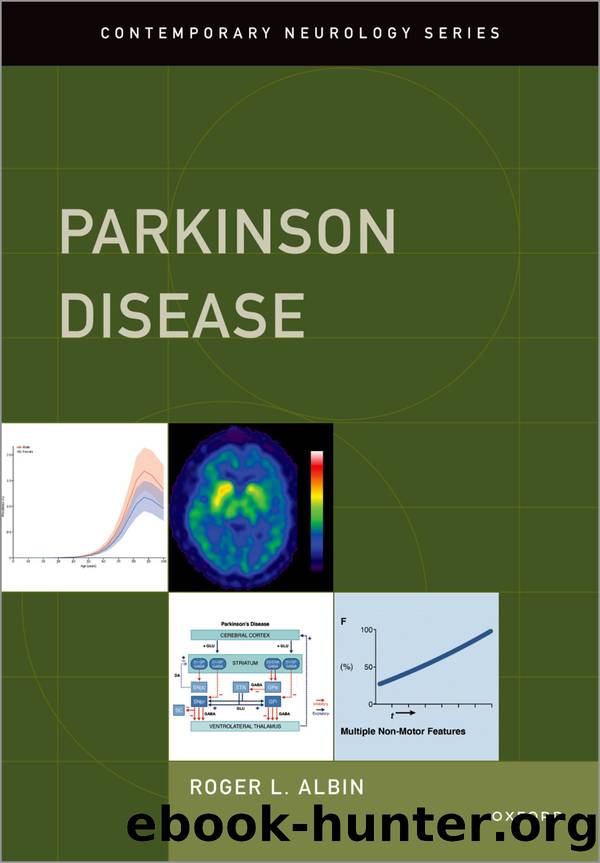Parkinson Disease by Roger L. Albin MD

Author:Roger L. Albin, MD
Language: eng
Format: epub
Publisher: Oxford University Press
Published: 2022-08-15T00:00:00+00:00
Figure 9.1 Micrographia in Parkinson disease (PD). Handwriting of simple loops. (A) Normal control. (B) PD patient treated with L-dopa. (C) Same PD patient off L-dopa. In (C), note progressive decrement of vertical loop amplitude and horizontal narrowing of loops. Notice improvements, but not normalization in (B). Reprinted with permission from Thomas M, Lenka A, Kumar Pal, P. Mov Disord. 2017;4:806â818.
Rigidity is an examination finding reflecting a specific form of increased muscle tone. Instruct patients to relax and allow the examiner to move limbs passively at selected joints. Commonly examined joints include the wrist, elbow, thumb carpometacarpal, and ankle joints. To assess axial muscle tone, passive movement of the neck is the preferred examination maneuver. PD is characterized by âplasticâ or âlead pipeâ rigidity with consistently increased resistance throughout the range of movement and not varying with changing velocity of movement of the examined body part. If tone is normal on initial examination, ask the patient to perform a âreinforcingâ or distracting maneuver. When examining one arm joint, ask the patient to repetitively wave or tap the contralateral hand. These maneuvers will often elicit rigidity in an apparently normal limb. Analogous reinforcing maneuvers are used when examining the legs or neck. In spasticity, in contrast, resistance increases with velocity and depends on position for some joint movements (e.g., the âclasp knifeâ phenomenon at the elbow). Paratonia or gegenhalten is also characterized by increasing resistance as the examiner makes more forceful movements. PD patients may also exhibit so-called cogwheeling, brief, regular, intermittent increases in resistance to passive movement as the examiner moves the examined body part. Cogwheeling is generally felt to be a manifestation of underlying resting tremor against a background of rigidity. As with plastic rigidity, cogwheeling may be brought out by use of reinforcing maneuvers.
Tremor is evaluated by a combination of observation and examination. Observation of tremor in the limbs or other body parts during the interview is good way to identify tremulous movements, sometimes in limbs, digits, or other body parts (head, jaw, tongue) of which the patient may be unaware. Similarly, observation during the interview can assist in characterizing tremors. Tremors should be characterized as present during rest, with fixed posture, during movement of the affected body part, or only during the performance of specific acts. During formal examination, ask the patient to relax the affected body part and apply some distraction, such as closing eyes and counting backward. Ask the patient to place the affected body part in a fixed posture. This is usually done for the arms by asking patients to hold their outstretched hands and arms out in front of them. Finally, observe the tremor during the performance of actions such as other parts of the motor examination, finger-to-nose (or toe-to-finger) testing for dystaxia, or producing a writing sample. PD-associated tremor is typically a 4â6 Hz tremor present when the affected body part is relaxed, and it improves markedly with fixed posture and/or use of the limb. In the hands, there is often the
Download
This site does not store any files on its server. We only index and link to content provided by other sites. Please contact the content providers to delete copyright contents if any and email us, we'll remove relevant links or contents immediately.
The Ultimate Bodybuilding Cookbook by Kendall Lou Schmidt(3860)
Warrior Workouts, Volume 2 by Stewart Smith(2502)
The Right Way to Do Wrong by Harry Houdini(1879)
10% Happier by Dan Harris(1671)
The Doctors Book of Home Remedies by Prevention Magazine Editors(1479)
Steroids: History, Science, and Issues by Standora Joan E.; Bogomolnik Alex; Slugocki Malgorzata(1454)
The Monk Who Sold His Ferrari by ROBIN SHARMA(1409)
The 7 Principles of Stress by Ori Hofmekler(1348)
Complete Guide to Prescription & Nonprescription Drugs 2014 by H. Winter Griffith(1308)
Spiritual Midwifery by Ina May Gaskin(1305)
The Dangerous Case of Donald Trump by Bandy X. Lee(1304)
Joey Green's Magic Health Remedies by Joey Green(1290)
The Ins and Outs of Gay Sex by Stephen E. Goldstone(1282)
First Aid for Colleges and Universities (10th Edition) by Mistovich Joseph J. & Limmer Daniel J. & Karren Keith J. & Hafen Brent Q(1215)
Massage Anatomy by Abigail Ellsworth(1210)
Anatomy of the Moving Body by Theodore Dimon Jr(1202)
The Anatomy of Sports Injuries by Brad Walker(1177)
The Ayurveda Encyclopedia by Swami Sadashiva Tirtha(1141)
Why Do Men Fall Asleep After Sex? by Mark Leyner(1022)
